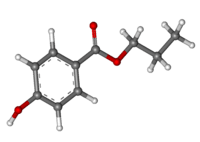Propylparaben
This article is about this particular compound. For the class of hydroxybenzoate esters, including discussion on possible health effects, see paraben.
 | |
 | |
| Names | |
|---|---|
| IUPAC name
propyl 4-hydroxybenzoate | |
| Other names
4-Hydroxybenzoesäurepropylester; propyl paraben; propyl p-hydroxybenzoate; propyl parahydroxybenzoate; nipasol; E216 | |
| Identifiers | |
| 94-13-3 | |
| ChEMBL | ChEMBL194014 |
| ChemSpider | 6907 |
| |
| Jmol-3D images | Image |
| KEGG | D01422 |
| PubChem | 7175 |
| |
| UNII | Z8IX2SC1OH |
| Properties | |
| C10H12O3 | |
| Molar mass | 180.2 g/mol |
| Density | 1.0630 g/cm3 |
| Melting point | 96 to 99 °C (205 to 210 °F; 369 to 372 K) |
| Hazards | |
| NFPA 704 | |
| Related compounds | |
| Related compounds |
Paraben Butylparaben Ethylparaben Methylparaben |
| Except where noted otherwise, data is given for materials in their standard state (at 25 °C (77 °F), 100 kPa) | |
| | |
| Infobox references | |
Propylparaben, the n-propyl ester of p-hydroxybenzoic acid, occurs as a natural substance found in many plants and some insects, although it is manufactured synthetically for use in cosmetics, pharmaceuticals and foods. It is a preservative typically found in many water-based cosmetics, such as creams, lotions, shampoos and bath products. As a food additive, it has the E number E216.
Sodium propyl p-hydroxybenzoate, the sodium salt of propylparaben, a compound with formula Na(C3H7(C6H4COO)O), is also used similarly as a food additive and as an anti-fungal preservation agent. Its E number is E217.
References
- Oishi (2002). "Effects of propyl paraben on the male reproductive system". Food Chemical Toxicology 40 (12): 1807–13. doi:10.1016/s0278-6915(02)00204-1. PMID 12419695.
